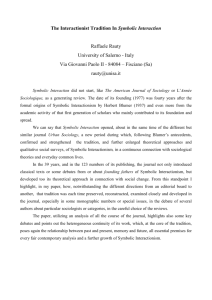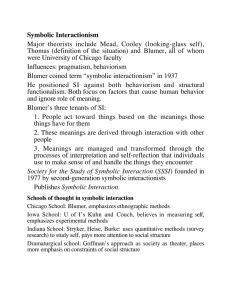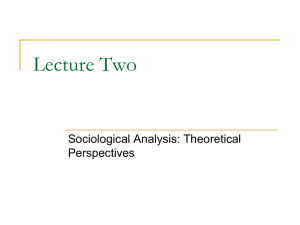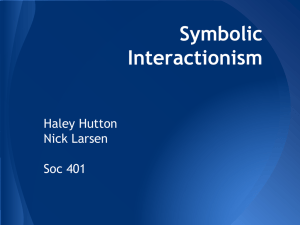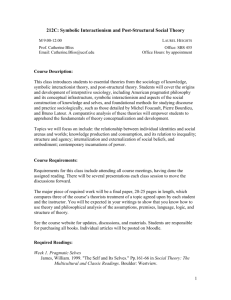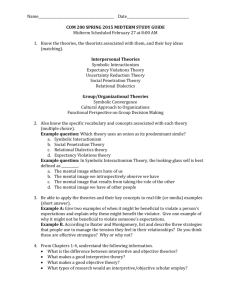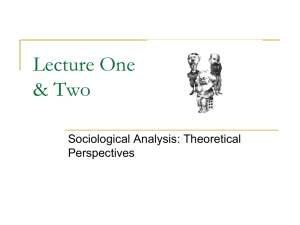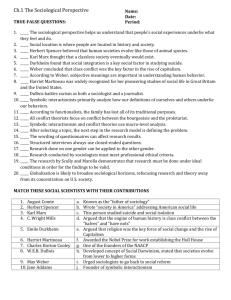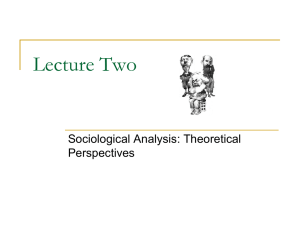What is Sociological Theory?
advertisement
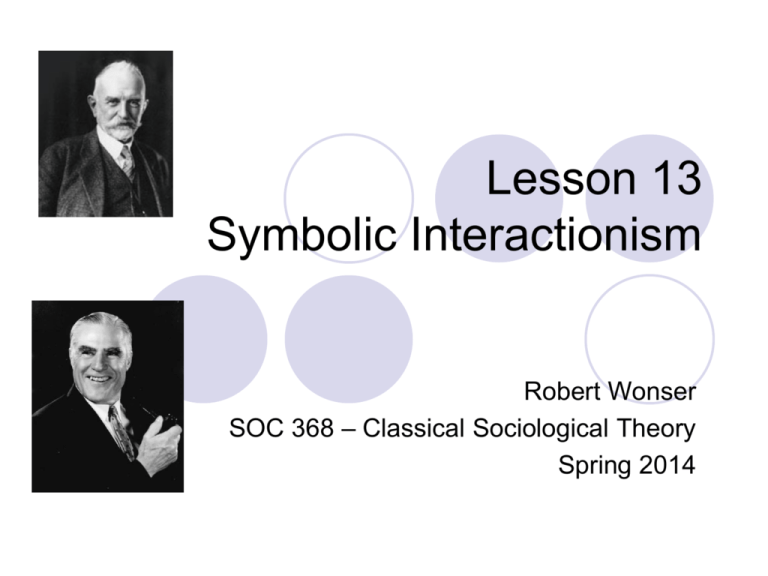
Lesson 13 Symbolic Interactionism Robert Wonser SOC 368 – Classical Sociological Theory Spring 2014 Basic Tenets of Symbolic Interactionism The foundation of society is language Human beings are primarily symbolic creatures Society is the exchange of meaningful symbols It is through symbols that humans create society, meaning, and reality Emphasis on conversation, face-to-face interaction, and the negotiation of reality 2 Central Topics of Symbolic Interaction the formation of identity the nature of the self “looking-glass self” Lesson 8: Early Women Sociologists, Classical Sociological Theory 3 Central Topics self-fulfilling prophesies and the power of labelling the dynamics of interaction the “social construction of reality” emotions habits 4 Thomas Theorem “If situations are defined as real they will have real consequences.” Lesson 8: Early Women Sociologists, Classical Sociological Theory 5 All macro-level social reality – culture, social structure – is a product of interaction Much of social life involves role-taking and role-playing A micro perspective Lesson 8: Early Women Sociologists, Classical Sociological Theory 6 George Herbert Mead society is “symbolic interaction” language is the most significant human invention language helps to create the “self,” the “mind,” and “meaning” I, me, generalized other the most effective means of social control is “self control” 7 Herbert Blumer and “Processual” Symbolic Interactionism Herbert Blumer, one of Mead’s most influential students coined the term “symbolic interactionism.” Blumer develops symbolic interactionism to reflect three basic principles: 8 Blumer’s Symbolic Interactionism Human beings act toward things on the basis of the meanings which these things have for them. The meaning of a thing for a person grows out of the ways in which other persons act toward the person with regard to the thing. The use of meanings by the actor occurs through a process of interpretation. 9 For Blumer, all of human social life is a process by which meanings are negotiated and interpreted, a product of “joint action.” Social structures and culture have only a weak influence on individuals. 10 “Structural” Symbolic Interactionism Some of Mead’s students, however, argue that Blumer has produced a version of symbolic interactionism that overly emphasizes process. Instead, they argue that social life, especially the self, is highly structured. Manford Kuhn’s Twenty Statement’s Test “I am” 11 For example, Sheldon Stryker argues that the self is hierarchically organized along a set of identities that vary in terms of: Commitment Salience The more commitment an individual has to an identity the greater the salience of the identity. The higher an identity in the salience hierarchy, the more likely that identity will be performed, and performed well. 12 Three tenets of Symbolic Interactionism Symbolic Interactionism, the process by which things are socially constructed: 1)Human beings act toward ideas, concepts and values on the basis of the meaning that those things have for them. 2) These meanings are the products of social interaction in human society. 3) These meanings are modified and filtered through an interpretive process that each individual uses in dealing with outward signs 13 Symbolic Interactionism: An example Are these the same? Do they have the same meaning? What do you think of when you see each? 14 Phenomenology and the Social Construction of Reality Peter Berger and Thomas Luckmann (1966) Ask the questions: How does a body of knowledge come to be accepted as “reality?” How do we create a shared reality that is experienced as objectively factual and is also subjectively meaningful? 15 How does the “social construction of reality occur?” Externalization – the creation of new social elements of reality that become new elements of that reality. Objectification – the perception of an ordered prearranged reality that appears to be independent of human beings themselves (reification). Internalization – the process by which individuals internalize the objectified reality (conformity to a reified reality). 16 Reification is “the apprehension of the products of human activity as if they were something else than human products – such as facts of nature, results of cosmic laws, or manifestations of divine will. Reification implies that man is capable of forgetting his own authorship of the human world, and further that the dialectic between man, the producer, and his products is lost to consciousness. The reified world is, by definition, a dehumanized world.” Berger and Luckmann, The Social Construction of Reality 17

